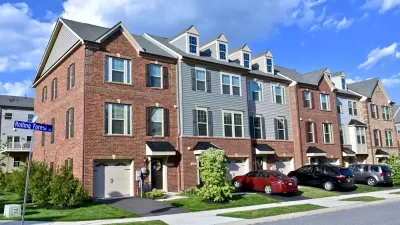Jed Kolko presents the findings of a study that examines the available stock of housing available to those earning the median income around the country in different cities around the country.
According to an article by Jed Kolko, a recent study of housing prices reveals that "compared with the longer-term past, homeownership still looks relatively affordable: home prices are still undervalued and mortgage rates remain near historic lows." In fact, "[in] most U.S. markets, the majority of homes for sale are within reach of the middle class, and buying is cheaper than renting in all of the 100 largest metros." The current report follows an inaugural study from last year.
The analysis pulls data on the prices of housing from Trulia, and defines middle class differently in each metro area under examination.
The study finds specifics about the many places where houses are still affordable for the middle class: "[in] 80 of the 100 largest U.S. metros, most of the homes for sale today are within reach of the middle class. In the most affordable housing markets, more than 80 percent of homes are within reach, with Akron topping the list at 86 percent. The 10 most affordable markets include eight in (or near) the Midwest, plus the southern markets of Columbia, SC, and Little Rock, AR. Five of the top 10 are in Ohio."
The less affordable places in the country shouldn't come as a surprise: "Seven of the 10 least affordable markets are in California, along with New York, neighboring Fairfield County, CT, and Honolulu. Only 14 percent of homes for sale in San Francisco are affordable to the middle class, even though median household income is higher in San Francisco than almost anywhere else in the country."
Kelko also provides analysis on the differences between markets. One conclusion he draws from the numbers: "In all, today’s unaffordable markets are likely to stay unaffordable. A collapse in demand is nothing to wish for; geographic constraints are nearly impossible to change; and strong political forces make building regulations difficult to relax."
FULL STORY: Where Buying a Home is Within Reach of the Middle Class

Maui's Vacation Rental Debate Turns Ugly
Verbal attacks, misinformation campaigns and fistfights plague a high-stakes debate to convert thousands of vacation rentals into long-term housing.

Planetizen Federal Action Tracker
A weekly monitor of how Trump’s orders and actions are impacting planners and planning in America.

In Urban Planning, AI Prompting Could be the New Design Thinking
Creativity has long been key to great urban design. What if we see AI as our new creative partner?

King County Supportive Housing Program Offers Hope for Unhoused Residents
The county is taking a ‘Housing First’ approach that prioritizes getting people into housing, then offering wraparound supportive services.

Researchers Use AI to Get Clearer Picture of US Housing
Analysts are using artificial intelligence to supercharge their research by allowing them to comb through data faster. Though these AI tools can be error prone, they save time and housing researchers are optimistic about the future.

Making Shared Micromobility More Inclusive
Cities and shared mobility system operators can do more to include people with disabilities in planning and operations, per a new report.
Urban Design for Planners 1: Software Tools
This six-course series explores essential urban design concepts using open source software and equips planners with the tools they need to participate fully in the urban design process.
Planning for Universal Design
Learn the tools for implementing Universal Design in planning regulations.
planning NEXT
Appalachian Highlands Housing Partners
Gallatin County Department of Planning & Community Development
Mpact (founded as Rail~Volution)
City of Camden Redevelopment Agency
City of Astoria
City of Portland
City of Laramie




























